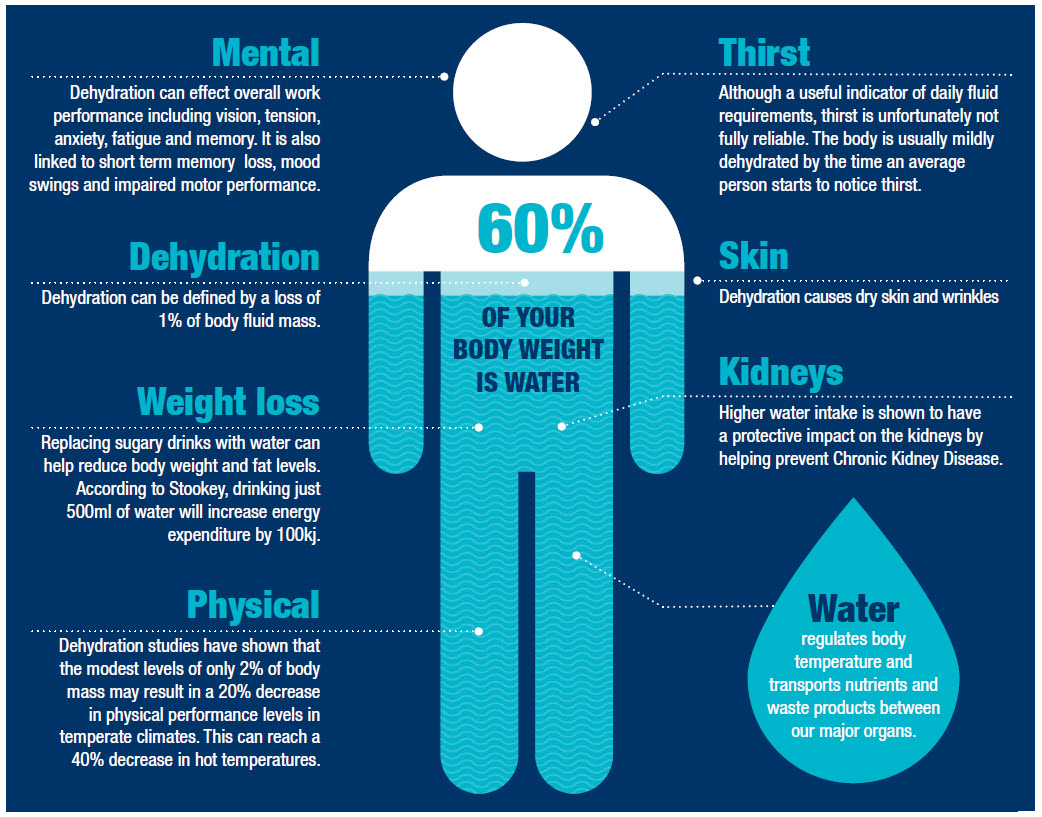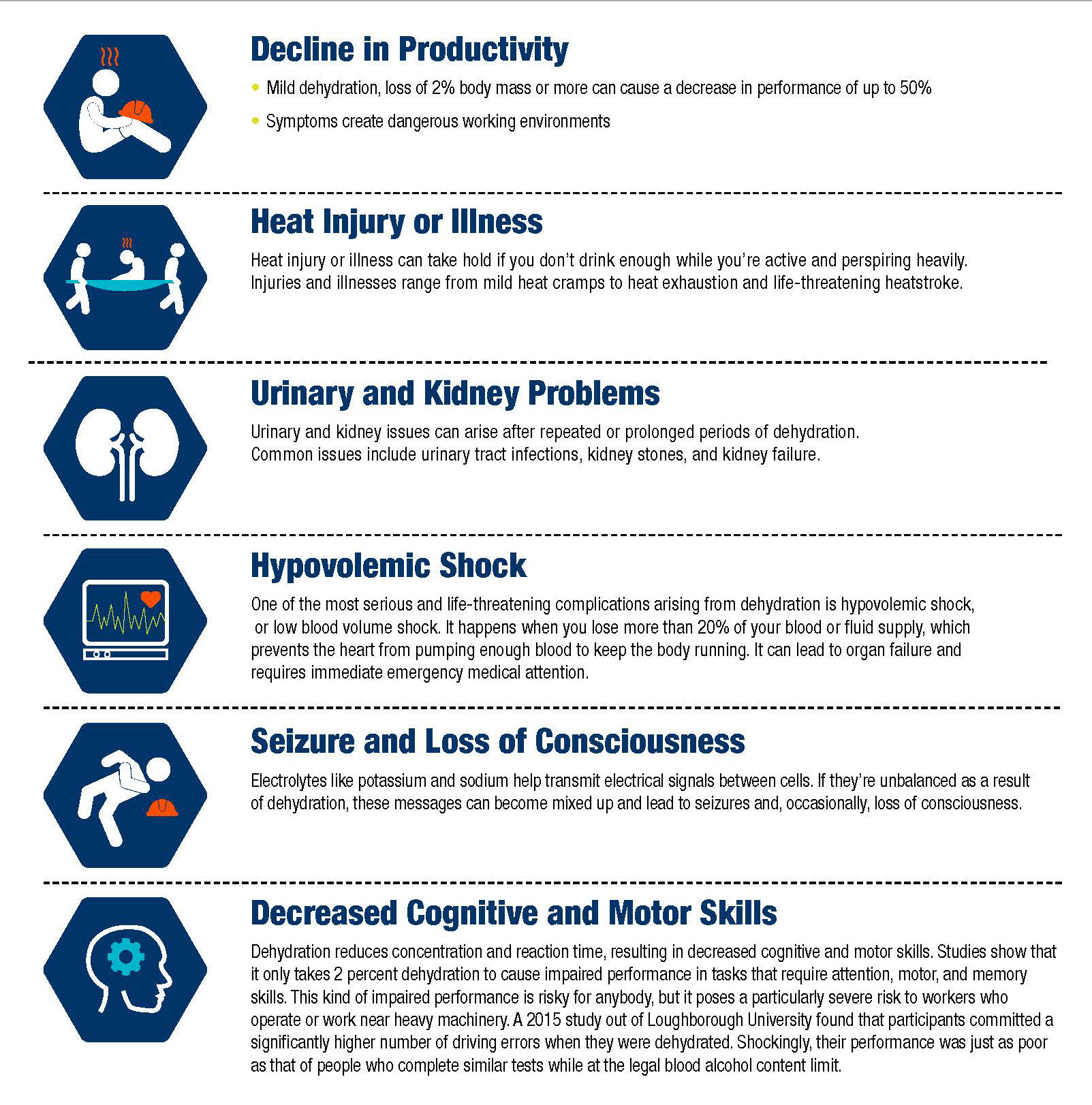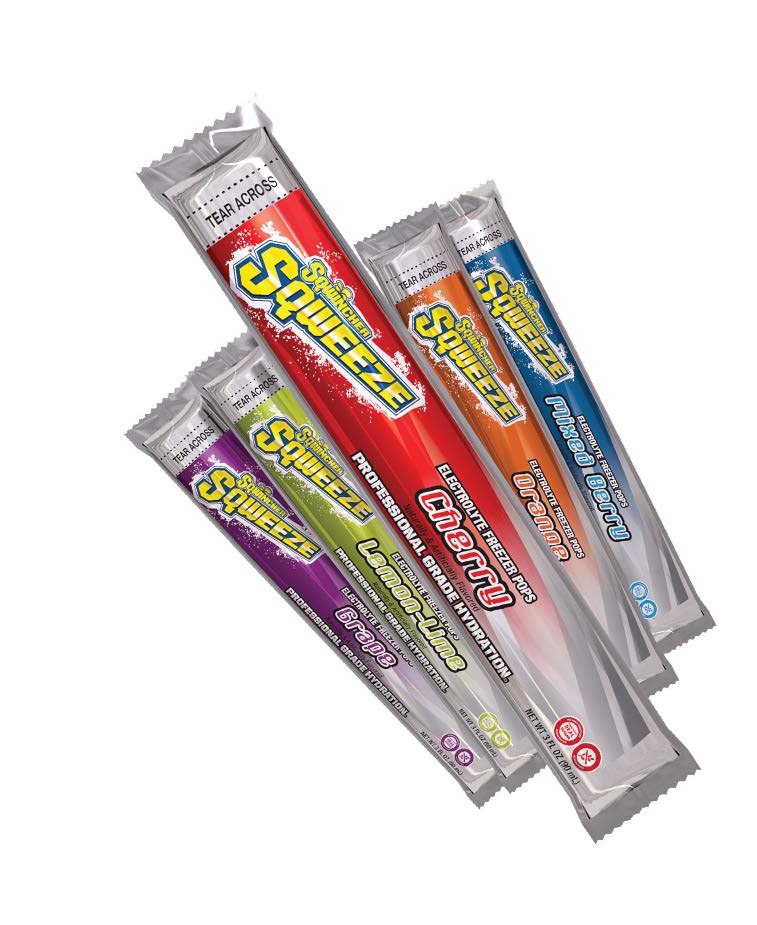If you work outdoors in Queensland, you are probably well acquainted with the sun and the difficulties inherent in working in our hot, dry climate. There are numerous hazards associated with outdoor work, including exposure to harmful UV rays and heat.
Numerous risk factors can impair workers' heat tolerance. High air temperatures and humidity, direct sun exposure, indoor radiant heat sources (ovens, hot manufacturing processes, etc.), restricted air movement, physical exertion, insufficient fluid intake (dehydration), personal protective equipment or clothing, certain medications, and physical condition are all risk factors for heat illness.
Hydration, evaporative cooling and sun protection are the most effective ways to work safely in hot workplaces.
Table of Contents
Hydration
Heat Stress
Sun Protection
Hydration
What is hydration?
Dehydration is defined as a 1% or greater loss of body mass as a result of fluid loss. The human body weight is made up of around 60% to 70% fluid. Dehydration occurs when the body is losing more fluids than being consumed, which causes the body to not perform maximally.
Thirst is an early indicator of dehydration, approximately 1% to 2% loss in body mass, but typically is only effective while as rest. It is important to note that thirst is not a reliable indicator of dehydration, because most people do not sense thirst until they are already dehydrated. Fluid loss from the body through normal daily activity; breathing, perspiration, urination, and defecation, is around 2.5L that needs to be replaced daily1. Even in mild dehydration, loses of 2% body mass or more, can cause a decrease in performance of up to 50%.

Infographic source: Hydration-Heat-Stress-Program[162922].pdf by PRYME
How does dehydration affect workers?
According to the guide to Heat Stress Management documented by PRYME, dehydration could reduce workers’ productivity, cause heat injury/illness, decrease cognition, etc.

Infographic source: Hydration-Heat-Stress-Program[162922].pdf by PRYME
What are some common effects of working in heat?
According to Safe Work Australia, working in heat can be hazardous and can cause harm to workers. The human body needs to maintain a body temperature of approximately 37 degrees Celsius.
If the body has to work too hard to keep cool or starts to overheat a worker begins to suffer from heat-related illness. This is a general term to describe a range of progressive heat related conditions including fainting, heat rash, heat cramps, heat exhaustion, and heat stroke. Some other common effects of working in heat include:

Infographic source: Hydration-Heat-Stress-Program[162922].pdf by PRYME
Tips on monitoring Hydration

Infographic source: Hydration-Heat-Stress-Program[162922].pdf by PRYME
Hydration products
SQWEEZE® POPS, ELECTROLYTE ENHANCED FROZEN POPS
Available at AusTech Saw & Tooling In-Store

Heat stress
Warehouse, manufacturing, and distribution industries are labor-intensive and frequently heat-intensive. This can result in heat stress, which has been shown to result in lost productivity due to decreased cognitive functions, absenteeism, and physical capabilities.
What is heat stress?
The human body works constantly to maintain an ideal temperature of 36–37° Celsius. When the body is unable to cool itself sufficiently to maintain a healthy body temperature, heat stress occurs. It refers to the total heat load on the body caused by all sources, such as ambient air temperature, radiant heat, air movement, relative humidity, clothing, and physical exertion.
Heat strain, on the other hand, is the body's reaction to heat stress. Physical fitness, acclimatisation, medical conditions, age, general health, weight, hydration levels, and medications all play a role.
The importance of mitigating heat stress in the workplace
According to a 2014 report published in the journal Environmental Science & Policy, heat has killed more people in Australia than all other natural hazards combined. According to studies, workers routinely overestimate their heat tolerance, believing they can work in high heat for an extended period of time. This is a source of concern for managers in charge of worker safety.
Heat stress reduces productivity as well. In order to reduce body heat production, most workers will naturally reduce work intensity and/or limit working hours in response to heat stress.
According to a report published in the journal Nature Climate Change, the cost of work absenteeism and reduced performance caused by heat in Australia during 2013/14 was approximately $885 per person based on a representative sample of 1726 employees. This equates to an annual economic burden of around $8.3 billion for the Australian workforce.
Cooling products
Sun Protection
Outdoor workers in Australia are exposed to up to ten times more sun than indoor workers, putting them at a higher risk of skin damage and skin cancer. Because of this increased risk, outdoor workers should wear sun protection all year.
Workers who are exposed to the sun are at risk of overexposure to ultraviolet radiation (UVR), particularly in Queensland. Long-term UVR exposure can cause sunburn in the short term and skin cancer and eye damage in the long term.
What’s UVR?
Ultraviolet radiation comes from the sun but can’t be seen or felt. When the ultraviolet (UV) index is three or above it starts to cause skin damage. This is even on cool and cloudy days, because UVR passes through clouds. It can also get through loosely woven clothing and can bounce off reflective surfaces like metal, concrete and water.
What are the risks of UVR?
Overexposure to UVR can cause:
• sunburn
• sunspots
• skin cancer
Sun protection at work
Because Queensland has the highest rate of skin cancer in the world, it's critical to limit your exposure to the sun. Businesses should create a sun-safe environment, and workers should take UVR-protection precautions.
UV radiation is not visible or felt like the sun's light or heat. Outdoor workers must wear sun protection every day, all year long, regardless of the temperature.
1. Slop on SPF 30 (or higher), broad-spectrum, water-resistant sunscreen. Re-apply every 2 hours or more if sweating. There are sunscreens available specifically for outdoor work that will not leave marks on equipment.
2. Slap on a hat that shades the face, ears and neck. Use a brim or legionnaire-style attachment on hard hats.
3. Slide on close-fitting, wrap-around style sunglasses. Check the swing tag to check they meet the Australian Standard for UV eye protection – AS/NZS 1067 or AS/NZS 1337 for safety glasses.
4. Slip on clothing that covers as much skin as possible. Long pants and collared, long-sleeved shirts are best.
5. Seek shade during breaks or move outdoor tasks to a shady spot where possible.

Source: Worksafe QLD
Sun protection products
Reference
- Big Ass Fans Australia Pty Ltd 2021, 'Staying cool: The cost of heat stress in the workplace and how big fans make a big difference', Safety Solutions, 01 October 2021, viewed 21 October 2014, <https://www.safetysolutions.net.au/content/confined-spaces/sponsored/staying-cool-the-cost-of-heat-stress-in-the-workplace-and-how-big-fans-make-a-big-difference-756519626>.
- PRYME 2021, A GUIDE TO HEAT STRESS MANAGEMENT, viewed 7 October 2021, <https://www.pryme.com.au/wp-content/uploads/2021/10/HydrationHeatProgram_PRYME.pdf>.
- SafeWork Australia 2021, Managing the risks of working in heat, viewed 12 October 2021, <https://www.safeworkaustralia.gov.au/sites/default/files/2021-10/Guide%20for%20managing%20the%20risks%20of%20working%20in%20heat_0.pdf>.
- Worksafe QLD 2021. Sun safety and skin cancer. [online] www.worksafe.qld.gov.au. Available at: https://www.worksafe.qld.gov.au/safety-and-prevention/hazards/hazardous-exposures/sun-safety-and-skin-cancer.